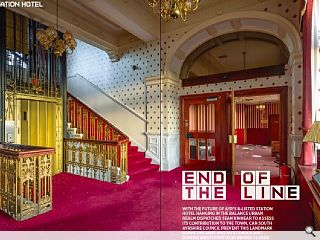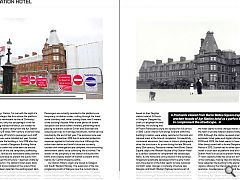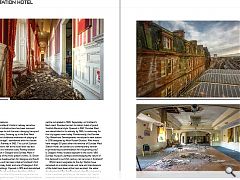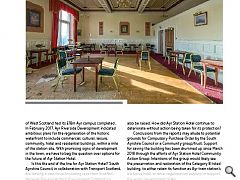Ayr Station Hotel: The End of the Line?
21 Oct 2019
With the future of Ayr’s b-listed station hotel hanging in the balance Urban Realm dispatched sean kinnear to assess its contribution to the town. Can South Ayrshire Council prevent this landmark going the same way as St Enoch and Dundee West? Photos by Behind Closed Doors Urban Exploration.
On approach to Ayr Station, I’m met with the sight of a large white sarcophagus-like form above the platform. The encasement is reminiscent to that of Chernobyl nuclear power plant, only this sarcophagus is not for preventing leaking radioactive fallout, but instead to stop crumbling roof debris falling from the Ayr Station Hotel.
The category B listed, 19th-century Victorian hotel, has been completely off-limits to passengers and staff since safety measures were installed last year. Scotrail was forced to vacate the building in July 2018 after Ayr Station Hotel was issued a Dangerous Building Notice in March. A secure cordon has since been set around the entire perimeter of the site; temporary scaffolding bridges, hoarding, fences and retractable safety barriers are in place at ground level to prevent the public from going anywhere near the structure – deemed unsafe by South Ayrshire Council. The station’s toilet areas, back of house and retail stores located on the ground floor of the hotel have been deserted, the waiting area’s dark interior only visible from a distance.
Decanted from their previous location on the Northern platform, personnel are now housed in make-shift staff facilities, complete with a temporary ticket office in a mini Portakabin-like city. Passengers are currently rerouted to the platforms via temporary circulation routes, cutting through the listed stone boundary wall, never coming closer than 5 meters of the building’s façade. After a brief period of severe disruption saw track buffers installed, preventing trains passing to stations south at Girvan and Stranraer and reducing services to 4 carriage maximums, normal service resumed by the end of last year. The exclusion zone was reduced in September 2019 due to extended protection measures applied to the hotel structure. Although the active train station and hotel’s future are currently unclear until investigations are complete, the surrounding environment seems to be continuing life as normal. The streets on the periphery of the station still bustle with traffic and a steady stream of footfall is present at the nearby Ayr Central shopping centre.
Ayr Station Hotel’s origins are traced to Glasgow and South Western Railway. The expansion of the line progressing south of Glasgow saw the current site as the third and final station constructed in Ayr. Increased tourist footfall from West coast holidaymakers, utilising the popular train services, prompted directors of Glasgow and South Western Railway to commission a 2nd hotel based on their flagship station hotel at St Enoch in Glasgow. Designed by chief civil engineer Andrew Galloway, the building was of French Renaissance style and opened for full service in 1886. Lavish interior furnishings inherent within the building’s creation were widely reported in the local and national press at the time of completion. Its beautifully considered elevations, best seen in historic photographs, show the structure in its prime during the late 19th and early 20th century. Postcards viewed from Burns Statue Square, depict the Western façade of Ayr Station Hotel as a perfect bookend to complement the streetscape fabric. As the horse and carts pictured in the building’s foreground eventually developed into the early motor cars, the exterior of the hotel seems to have remained constant.
Later changes in company structure saw Glasgow and South Western Railway become part of London Midland and Scottish Railway Grouping in 1923. With the forming of ‘British Rail’ after nationalisation in 1948, Ayr Station Hotel subsequently passed ownership to British Transport Hotels. Sold again in the early 1950s, the hotel seems to have changed hands several times at the helm of private hoteliers before finally closing around 2013. Although the station received small alterations in automatic ticket gates and digital information screens in 2006 and 2009, the hotel seems to have been neglected. After being issued with a formal Dangerous Building’s Notice in 2013, Scotrail had no other option but to install a crash deck at platform level and netting to Ayr Station Hotel’s structure to prevent falling debris. The 71-room capacity hotel has since lain dormant. Gaps in the roofscape, missing tiles and damaged guttering have subjected the building to the elements and water ingress; allowing the interiors to slowly erode. Architrave openings, moulded eave cornices and deep entablatures are among some of the intricate elevational treatment attributing Ayr Station Hotel’s listing building entry. Unfortunately, the specialist PVC protective sheeting currently wrapped around most of the structure hides these beautiful features.
In-line with Scotland’s historic railway narrative, train stations and infrastructure has been removed from the landscape to suit the ever-changing transport needs of the country. Growing up in the East Neuk of Fife, I have vivid childhood memories of playing at “the old railway bridge”; abandoned with the closure of the Fife Coast Railway in 1965. This cull of Scottish historic railway fabric felt at the local level has also been witnessed on a national scale. Railway station hotels at St Enoch in Glasgow and Dundee West in Tayside are some of the more potent victims. St. Enoch Station Hotel was headquarters for Glasgow and South Western Railway and has been cited as Scotland’s first purpose-built railway hotel, and one of Glasgow’s first electrically lit buildings. Opened in 1876 and demolished in 1977, the hotel’s red sandstone elevations strike a fine complement to that of Ayr and the similarities are unsurprisingly visually evident. St Enoch Station Hotel site has since been replaced by the synonymous shopping centre completed in 1989. Separately, on Scotland’s East coast, Dundee too lost its station hotel of grand Scottish Baronial style. Opened in 1847, Dundee West was demolished in its entirety by 1965, to make way for the city bypass seen today. Paradoxically, the Dundee City Waterfront Developments introduced a new station in 2018 designed by Nicol Russell Studios. Who would have imaged 50 years after the removal of Dundee West Station Hotel, we construct a contemporary version to provide key accommodation for the growing city? Is Sleeperz Hotel, located adjacent to the iconic V&A Dundee museum, perhaps acknowledging the return of this demand to suit 21st-century rail services in Scotland?
Whilst recent upgrades to the Ayr Station have remained on a smaller-scale, and care and maintenance of the hotel have been all but non-existent, the wider development of Ayr itself has been steadily progressing. In the immediate periphery of the station, Ayr Central shopping centre and a Morrisons store were added to the urban fabric in 2007. In 2011, the nearby University of West Scotland had its £18m Ayr campus completed. In February 2017, Ayr Riverside Development indicated ambitious plans for the regeneration of the historic waterfront to include commercial, cultural, leisure, community, hotel and residential buildings, within a mile of the station site. With promising signs of development in the town, we have to beg the question over options for the future of Ayr Station Hotel.
Is this the end of the line for Ayr Station Hotel? South Ayrshire Council, in collaboration with Transport Scotland, are leading a task force (including reps from ScotRail, Network Rail and Historic Environment Scotland) to address public safety issues at the site. Detailed structural investigations assessing the building’s integrity are currently on-going leading to speculation around the future of the building.
At this current moment in time, the fate of the Category B listed structure seems almost entirely dependent on the outcome of these reports. We can only hope the options tabled for this site include retaining the hotel as a paramount objective. Although there was a lapse in care of the building post-2013 – further compounding its predicament – questions over enforcement of historic building owner’s obligations must also be raised. How did Ayr Station Hotel continue to deteriorate without action being taken for its protection?
Conclusions from the reports may allude to potential grounds for Compulsory Purchase Order by the South Ayrshire Council or a Community group/trust. Support for saving the building has been drummed up since March 2018 through the efforts of Ayr Station Hotel Community Action Group. Intentions of the group would likely see the preservation and restoration of the Category B listed building, to either retain its function as Ayr train station’s exclusive hotel or other regeneration outputs to support the wider development of Ayr.
It would be a real shame if the hotel was to finally succumb to similar fates at station hotels in Glasgow and Dundee mentioned earlier, as Ayr Station Hotel stands as one of the few remaining buildings of its kind. Removal of this unique historic rail line relic would have a long-lasting impact on our ever-reducing historic built environment. We must learn from these historic cases and push for alternatives against demolition sanctioned through arguments of financial implications. Too often are we hoodwinked into thinking removal of so many sites on The Buildings at Risk Register in Scotland is the most “economical and viable solution”.
|
|






